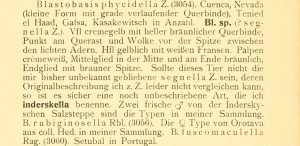

 +2Kontinente:EUAS
+2Kontinente:EUAS2. Diagnose
2.1. Erstbeschreibung
Die von Zeller beschriebene Art, zu der Caradja Konspezifität in Betracht zieht, ist Hypatopa segnella.
3. Biologie
3.1. Nahrung der Raupe
Noch unbekannt! Der Verdacht dürfte auch hier auf Limonium-Arten (Plumbaginaceae) fallen, an denen die Raupen der anderen Arten der Gattung leben.
4. Weitere Informationen
4.1. Andere Kombinationen
- Blastobasis inderskella Caradja, 1920 [Originalkombination]
4.2. Taxonomie
Adamski & Sattler (2019: 17) berichten: "Blastobasis inderskella Caradja, 1920, is one of numerous micromoths almost never referred to again in the scientific literature after its description. During an examination of Caradja types by KS in 1987, it was discovered that B.inderskella was misplaced in Blastobasidae and should be transferred to the Gelechiidae. A manuscript transfer of inderskella to the Gelechiidae, but without assignment to a specific genus, was made by KS in the collection of the Natural History Museum, London, and specimens from Mongolia were associated with that name. The transfer from Blastobasidae to Gelechiidae was subsequently formalised by Sinev (2014: 81). We are now able to assign inderskella to the genus Holcophora Staudinger, 1871, with which we newly synonymize Aponoea Walsingham, 1905."
4.3. Faunistik
Nach Adamski & Sattler (2019) zunächst durch den Typenfundort in der Inderskyschen Salzsteppe in West-Kasachstan bekannt, der nach der üblichen Abgrenzung (Ural-Fluss) zwischen Europa und Asien ca. 10 km in Asien liegt. Huemer & Karsholt (2020) nehmen die Art trotzdem in ihre Europa-Liste der Gelechiidae Europas auf und kommentieren: "Holcophora inderskella. The species was included in Holcophora by Adamski and Sattler (2019). It was described from Lake Indersky in Western Kazakhstan and is here attached to the European fauna despite a distance of ca. 10 km from the type-locality to the widely accepted natural border of the Continent, the Ural River." Nach anderen Abgrenzungen fällt dieser Teil auch noch Europa zu.
Adamski & Sattler (2019) können aus der Mongolei weitere Funden anführen, die wahrscheinlich zur gleichen Art gehören: "Fresh specimens from Mongolia, collected by Z. Kaszab, Budapest, were tentatively identified by KS as inderskella and placed under that name in the NHMUK collection but without a generic assignment (further specimens exist in HNHM Budapest). We are confident that the generic placement in Holcophora is accurate, however, the specific identity should be re-assessed when fresh specimens from the type-locality (Kazakhstan) become available."
Das Vorkommen in Europa - auch westlich des Ural-Flusses - sollte geklärt werden.
4.4. Typenmaterial
Adamski & Sattler (2019) teilen zum Typenmaterial mit: "Blastobasis inderskella Caradja, 1920: 122. Lectotype ♂ [damaged], KAZAKHSTAN: Oz Inder, (‘Indersky Salzsee’), 22.vi.1907 [(Bartel)], designated by Popescu-Gorj 1992: 156 (MGAB, Bucharest), (Fig. 14). Paralectotype, ♀ [damaged], same label data as above, (Fig. 15)."
(Autor: Erwin Rennwald)
4.5. Literatur
- Adamski, D. & K. Sattler (2019): Holcophora Staudinger, 1871, a senior synonym of Aponoea Walsingham, 1905, syn. n., (Lepidoptera, Gelechioidea, Gelechiidae): with Holcophora inderskella (Caradja, 1920), comb. n., transferred from Blastobasis Zeller, 1855 (Blastobasidae). — Nota Lepidopterologica, 42 (1): 17-25. [zum open-access-Artikel auf pensoft.net]
- Erstbeschreibung: Caradja, A. (1920): Beitrag zur Kenntnis der geographischen Verbreitung der Mikrolepidopteren des palaearktischen Faunengebietes nebst Beschreibung neuer Formen. III. Teil. — Deutsche Entomologische Zeitschrift Iris, 34: 75–179. [Digitalisat auf biodiversitylibrary.org]
- Huemer, P. & O. Karsholt (2020): Commented checklist of European Gelechiidae (Lepidoptera). — ZooKeys 921: 65–140. [zur Arbeit und PDF-Download auf zookeys.pensoft.net]




